Effect of processing Verdejo grape must by UHPH using non-Saccharomyces yeasts in the absence of SO2†
Abstract
Ultra-High Pressure Homogenization (UHPH) is an emerging non-thermal technology that can eliminate wild microorganisms from grape juice facilitating the use of non-competitive non-Saccharomyces yeast in fermentation to modulate the sensory profile. The use of UHPH processing in must from Verdejo variety grapes (Vitis vinifera L.) produces a more varietal profile reducing the contents of fermentative fruity varietal esters (−25–50%) and enhancing the release of volatile thiols (+25–75%). The aromatic profile of UHPH wines is clearly separated of controls by the aroma PCA. Additionally, the inactivation of oxidative enzymes by UHPH preserves a better color in wines with a paler yellow color and lower b* values. A better implantation of some non-Saccharomyces yeasts such as Lachancea thermotolerans can help to reduce the pH in wines from warm areas. Improved varietal aroma, paler wine color and, depending on the strain fermented with, lower pH help control the impact of global warming on wines.



 Please wait while we load your content...
Please wait while we load your content...